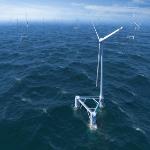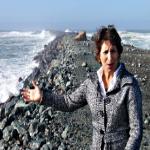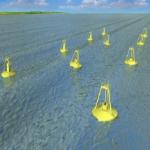26 November 2010

Photo: Courtesy of Principle Power, Inc.
Rendering of floating offshore wind farm
One of the newest sources of alternative energy is also one of the oldest - water power. The 19th century water wheel, though, bears no resemblance to the 21st century contraptions powered by ocean waves.
The wave energy sector has been slow to coalesce around one technology. Quite the opposite. Unconventional ideas are blooming like algae along America's Pacific Coast in a proliferation of creative electric engineering.
Harnessing the power of waves
The steady, powerful pounding of the ocean surf at this time of year is a reminder why marine energy developers love the Pacific Northwest. Huge waves crash against the jetties at the mouth of Tillamook Bay on the Oregon Coast. Columns of spray shoot in the air.
"The wave energy potential is very large here," says Stephanie Thornton, American program director for the Wave Energy AS. The Norwegian company proposes redesigning jetties and breakwaters like these to include electricity generators built inside.
"It's designed in such a way that it has open chambers on the wave facing side," Thornton explains. "When the waves crash or hit against this device, water fills these chambers and runs into the back where the turbine is. Basically it's very similar to a hydroelectric dam where water just flows through and drives a turbine."

VOA - T. Banse
Wave Energy AS program director Stephanie Thornton hopes to harness the power of the crashing waves near Barview, Oregon.The industry is in its infancy. It's a period of great experimentation, overflowing with creative technologies.
"Once they figure out if it can work from a technical standpoint, then it's the business side of it," Thornton says. "The economics may be the key issue."
Innovation
The Scottish firm, Aquamarine Power, is one of several other foreign companies scouting here.
Aquamarine outreach coordinator Theresa Wisner recently described her firm's near-shore device to the Tillamook County Commission. Called the Oyster, it's a very large mechanical flap resting on the sea bottom.
"What happens is a wave comes in from the ocean. It forces the top of the Oyster down onto some pistons," says Wisner. "Those pistons force that water into high pressure water line that goes ashore to a Pelton wheel, which is one of the oldest ways of generating electricity."
Wisner was followed to the podium in Tillamook by a representative for Seattle, Washington-based Principle Power. Kevin Bannister described his company's plans for floating wind farms offshore of Oregon and Portugal.
"The design came from the oil and gas industry. So, semi-submersible platforms like this one are not terribly new," says Bannister. "The integration with a wind turbine however is a new idea."
Yet another company diving into the competition is a Salem, Oregon based startup, M3 Wave Energy Systems. Its idea relies on wave pressure passing over air-filled pillows on the sea floor. The pulses compress air, which can then be used to spin an electric turbine.
Tillamook Public Utility District manager Pat Ashby has seen even more far out ideas cross his desk.
"We've become kind of a bulls-eye for world developers," says Ashby.

Courtesy Ocean Power Technology
Rendering of wave energy parkPrototype ocean energy devices are generating electricity in Scottish, Hawaiian and Australian waters, but not here yet.
Coming first to the U.S. West Coast will likely be a bobbing buoy generator next year. Eventually, a field of 10 floating buoys, anchored to the ocean floor, would bob up and down with the swells. The movement creates electricity. Ashby says a floating wind farm also seems plausible near term because wind power is well understood.
"The others have got new technology that needs to be tested. It's not really existing anywhere in the world right now. And the devices that produce the energy and their ability to withstand saltwater - corrosive elements - need a lot of work yet."
Winning people over
Ashby says community acceptance also needs some work yet.
At the Port of Garibaldi, Oregon, Darren Mobley prepares his boat for winter crabbing. He's among the many fishermen and crabbers who worry about how harnessing ocean energy will impact them.
"They're talking about a big area around them that would be closed to fishing," says Mobley. "We can't afford to have any more fishing ground taken from us."
Wave Energy's plans to put electric generators inside the breakwaters is the only idea that wins favor from Mobley.
U.S. and foreign governments are keen on the sector and are pumping in lots of funds to float more prototypes. But whether electricity can be generated in the ocean at affordable prices remains an open question